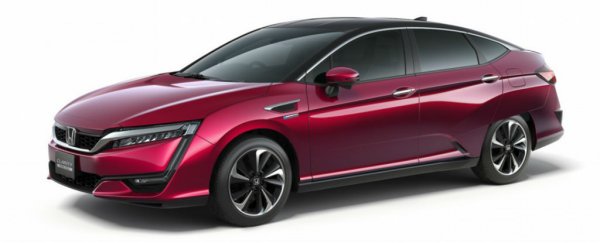Just when everyone's getting all excited about electric cars usurping their fossil fuel-guzzling counterparts, Honda has announced that its hydrogen-powered cars will go on sale in Japan as early as March 2016, with launches in Europe and the US to follow.
The five-seated sedan, called the FCV Clarity, can travel 700 km (434 miles) on a single charge. It's been priced at 7.66 million yen, or US$62,807, which puts it just in the affordability range for the average consumer, the Japanese automaker saying it expects to sell far more than the 72 units it sold of its previous-generation model, the FCX Clarity. "We want this car to be the trigger for the 'hydrogen society'," Honda operating officer, Toshihiro Mibe, told Reuters at the Tokyo Motor Show in Japan this week.
A Honda hydrogen-powered car is nothing new. Back in 2008, the FCX Clarity was leased to a handful of private buyers in California as part of a subsidised trial deal, but things didn't go so well that time around.
For one thing, the car cost 10 times more than it does now, and on top of that, it was 30 percent less powerful. The hydrogen fuel cell stack was also incredibly bulky, and the last thing you want to do is spend more than half a million dollars on a car you can barely fit into. "Until this point, fuel cells have been so large that they needed to be packaged elsewhere in the vehicle, like in Toyota's Mirai, which has its fuel cell stack in the centre of the vehicle, cutting into interior space," Nick Jaynes writes for Mashable.
The FCV Clarity, on the other hand, features a fuel cell stack that's 33 percent smaller, now taking up the same amount of room under the hood as a typical V-6 engine.
Hydrogen-powered cars work by having the fuel cell stack convert hydrogen into electricity, which powers an electric motor via a lithium-ion battery pack. "Essentially, think of it as an electric vehicle that can be refilled in 3 minutes and emits only water vapour out of its tailpipes," says Jaynes.
And therein lies the biggest hurdle in convincing drivers to join the "hydrogen society" - you're gonna need at least one hydrogen station in your local area to make buying one of these environmentally friendly vehicles in any way practical. Joann Muller reports at Forbes that companies like First Element and Air Liquide are installing some in Northeastern US and California, supported by government grants and loans from Toyota and Honda, but the rollout has so far been slow.
Not that Honda isn't aware of the challenges its drivers could face in finding places to charge - it's now developing a personal-use Smart Hydrogen Station, which is designed to be installed at home so you don't have to go looking for a re-up. "There's no word on when that might be available, but if it's affordable, it could be a huge breakthrough in speeding the adoption of fuel cell vehicles," says Muller.
It's exciting to see a car company go all-in on a vehicle that completely eliminates the need for toxic emissions. In a world where outdoor air pollution is killing more than 3 million people every year, with automobile exhaust being a significant part of the problem, alternatives like this are crucial. But only time will tell if there's truly a market for hydrogen cars out there.
"Compared to 10 years ago, I think fuel cell vehicles have developed significantly in terms of the technology," Honda president Takahiro Hachigo told Muller. "Ten years ago, we said fuel cells could not be driven in cold weather, for example, and that the hardware was too heavy. Today, fuel cells are equal to gasoline engine cars."
